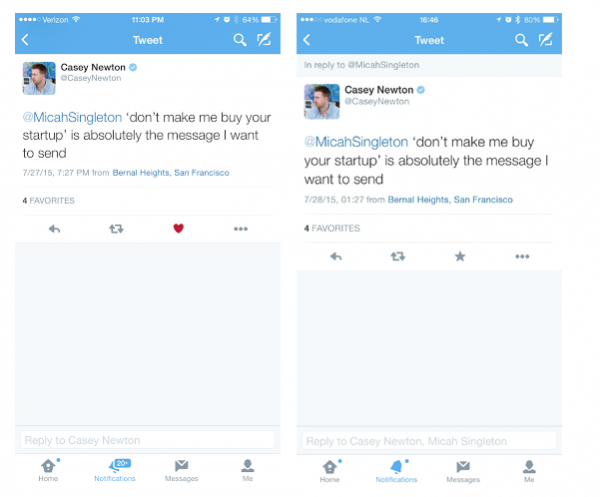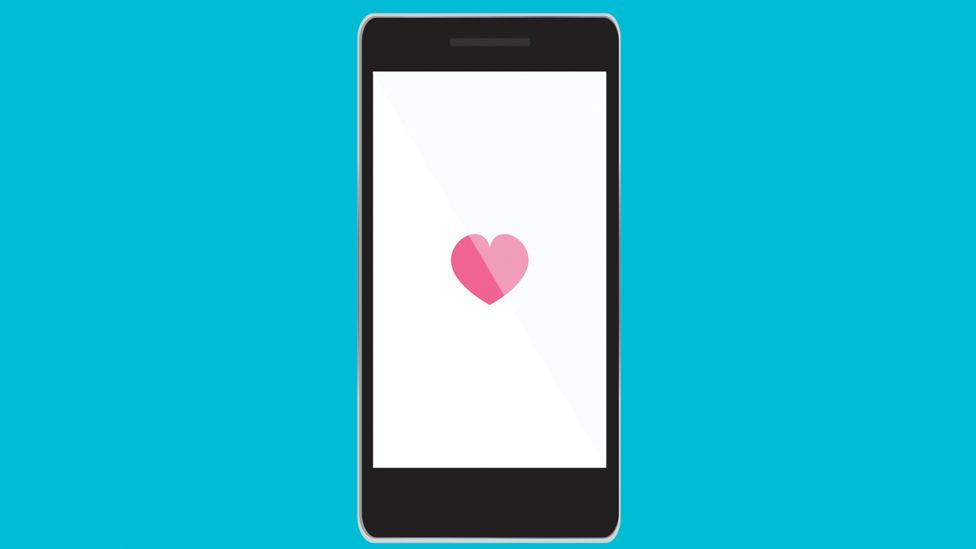It could be said that there’s a big difference between giving something or someone a “like” and calling them a “favorite,” especially Twitter, which feels that it’s compelling enough of a difference to make a change.
The company has decided to follow a path similar to that of rival social network Facebook by replacing its traditional “favorite” button with a heart, indicating more of a “like,” according to AdWeek.
Twitter announced the change-up earlier this morning in a tweet, indicating that “You can say a lot with a heart. Introducing a new way to show how you feel on Twitter.”
You can say a lot with a heart. Introducing a new way to show how you feel on Twitter: https://t.co/WKBEmORXNW pic.twitter.com/G4ZGe0rDTP
— Twitter (@twitter) November 3, 2015
This isn’t the first time that a popular social network has mimicked another, as Facebook did the same in early 2014 with its Trending section (similar to Twitter), along with Place Tips, which could be compared in some ways to Snapchat’s Live Stories.
After testing the feature, Twitter’s product manager Akarsham Kumar indicated that “we found that people loved it,” noting that the icon/like button has become quite popular on the company’s Periscope livestreaming app, where hearts practically pour in with each like that the broadcast gets. “We’re delighted to bring them to Twitter and Vine, making them the common language for our global community.”
The Twitter community’s reaction to the change has been mixed. The following tweets show both favoritism and “dislike” for the new design.
at least twitter is doing bold stuff, not afraid to upset whiny core users. that’s what worked for Facebook
— Erin Griffith (@eringriffith) November 3, 2015
TWITTER CHANGED FAVORITES TO LIKES?!
— mr.virtue (@venessa_chun) November 3, 2015
The Verge also had something to say on the matter, indicating that “stars and hearts are not synonymous. To star something is to measure its quality. To heart something is to emote it. These are lessons learned long ago in grade school: gold stars were reserved for a 100 percent on a math test or when Mario defeated Macho Grubba, hearts were doled out like Valentines by a horny Periscope user. To change the icon would change the very meaning of a favorite tweet,” said the article.
The image below, also from The Verge, points out the subtle differences that can come between favoring a tweet and “liking” a tweet, especially given the subtext of the tweet itself.

Twitter investor Chris Sacca defended the idea of replacing favorites with hearts just last month, saying, “A very high bar is set by using the word ‘Favorite’ on Twitter. Favorite is a superlative. It implies a ranking. In the early days of Twitter many of us interpreted the word literally and only keep a few Tweets in our favorites that were truly, well, our favorites. Today, many of my friends and I use the star as a ‘Like’ button equivalent or even a simple acknowledgement that we saw a Tweet. Whereas other people use favorites as bookmarks. However, the majority of users are baffled by favorites and they don’t end up using the star much, if at all.”
The question still remains if the change will be in Twitter’s favor for the long run, but things are looking positive. Results from an April 2015 SwiftKey Emoji Report discuss the effectiveness that a simple emoji icon can have, which speaks to the “heart” that Twitter is using to indicate liking something.
It’s a large report, but here are some general findings that could be back Twitter’s change:
- In terms of emojis that are used the most, hearts came up third on the list, right behind happy and sad faces. That indicates that it’s heavily used, particularly on sites that support the emoji, including Instagram and Facebook. As a result, it’s easy to see why Twitter would adopt it in favor of stars, which is number 26 on the list.
- When it comes to emoji categories as a percentage of overall usage, hearts are used 12.5 percent, which is far greater than the use of other emoji, such as monkeys, party and romance. Happy faces make up a majority with around 45 percent, with sad faces coming in second with 14.33 percent.
- Worldwide, more positivity is being accepted on social media than negativity, particularly with messages revolving around emoji like the hearts utilize. Overall, statistics show that they are 70 percent positive.
- French speakers use heart emoji quite extensively, four times more than the average emoji user. That makes the heart symbol accepted more worldwide than, say, stars.
The full report, which breaks down more extensive emoji usage, can be found here.
Additionally, there’s evidence that indicates that emoji use is on the rise across both social networks and mobile communication. That being the case, Twitter users will likely learn to love the heart.

